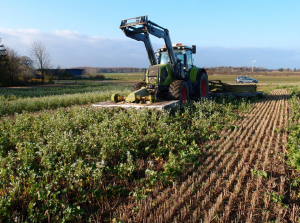
In recent years, catch crops as a source for agricultural biomass for biogas plants have attracted increasing interest from reseachers and farmers. These plants, grown after the main crop, significantly reduce nutrient losses within the soil and reduce the need for additional fertilizer. This makes catch crops an option in order to not only save costs but also to reduce pollution of the aquatic environment. Currently in Denmark, it is compulsory to cultivate catch crops on farms larger than 10ha, or on 10-14% of Danish farmland. It is therefore relevant to find a means of increasing biomass yield to ensure economic feasibility as well as the sustainability of food for both human and animal consumption.
Catch crop cultivation combined with its use for biogas production would increase renewable energy production in the form of methane, without interfering with the production of food and fodder crops. Today the generally low biomass yield of catch crops is a limiting factor for using these crops as co-substrate in manure-based biogas plants.
Previous studies have been carried out investigating factors such as fertilization, time of establishment and harvest, the parameters upon which biomass yield of catch crops depends. A study conducted from Aalborg University, however, focused on a new agricultural strategy to harvest catch crops together with the residual straw of the main crop biomass and thereby to increase their methane yield per hectare.
This new agricultural strategy may be a good alternative to achieve economically feasible biogas production from catch crops and straw.
This experiment used spring wheat as the main crop. For the first trial variation, seven catch crops including fescue and perennial ryegrass were planted both simultaneously and 2 months after the main crop. The straw stubble and the catch crops were harvested six and a half months after initial planting, about 2 months after the harvest of the main crop. The second trial had two parts: the first involved harvesting both the stubble and the cash crop together but at a height of 40cm in one plot and at 55cm in another. The second involved only the main crop in order to obtain values for the pure spring wheat. For all trials, biomass yield and methane yield were measured.
All catch crops, when combined with the wheat stubble, provided a higher methane yield than the wheat by itself. The different catch crops with the wheat stubble had a range of 3.3 to 3.6 t of total solids per hectare, resulting in a methane yield range of 165-239 m3 t-1 volatile solids. Of the seven, fescue, a narrow-leaved grass, achieved the highest methane yield.
The second trial’s scope was to study the effect of harvest time on composition and specific methane yield of wheat straw stubble left on the fields after harvest of the main crop. Results showed that late harvest of straw/stubble could benefit methane production since soil microorganisms may partially degrade the organic matter, resulting in higher methane specific yields when this biomass is used for biogas production.
These results show high biomass and methane yields for all trial variations and prove that catch crops could be a feasible option to increase methane production in biogas plants. Though it is vital to remember the effect that variables such as climate conditions and soil quality can have on biomass yields, this experiment nonetheless proves that catch crops are an economically feasible option for biomass, especially when combined with main crop stubble.
This post is based on an paper presented at the 22nd EUBCE and written by Molinuevo-Salces, B. et al. of the Aalborg University, Copenhagen. The full paper and slides are published in the conference proceedings and can be purchased by clicking the link below.


